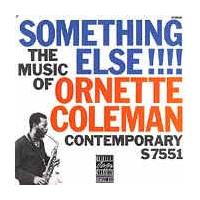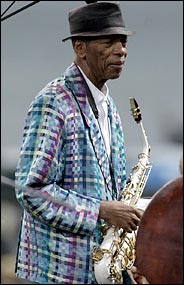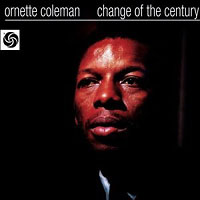 Have a Harmolodic Day! International Ornette Coleman Day comes but once a year.
Have a Harmolodic Day! International Ornette Coleman Day comes but once a year. I never cease to be mesmerized whenever I put on one of the first two discs of the great Beauty is A Rare Thing box set. There was something so transcendent about that quartet of Ornette Coleman, Don Cherry, Charlie Haden and Billy Higgins playing those outstanding compositions with the exhilarating freedom of the harmolodic approach to harmony, rhythm and improvisation. This material is so good it nearly eclipses the consistently incredible music that Ornette has been playing and composing over his entire life thus far (he turns 79 today-- and I look forward to 79 more years from this giant).
 The steady truth of Ornette's titles are striking. From the tautological This Is Our Music to the boldly prophetic The Shape of Jazz to Come to the sublime "Music Always" or "I Heard It Over The Radio" to the poignant "Beauty Is A Rare Thing" (even when beauty is free flowing from the tenor in hand it is never "common") to the simply stated Ornette! Even more striking are the qualities that emerge from these compositions in the hands of some great interpreters. Don Byron's take on "Check Up" to open A Fine Line is stunning. Or the deeply satisfying Paul Plimley Trio's take on "I Heard It Over the Radio" from Density of the Lovestruck Demons. The Ginger Baker Trio's take on "Ramblin'" (with Charlie Haden on bass) from Going Back Home is also a stunner. And his most famous composition -- "Lonely Woman" -- has endured numerous interpretations (the melodic line is an obvious attraction on that one). Though nothing I've heard has really equaled the quality of that initial 1959 recording.
The steady truth of Ornette's titles are striking. From the tautological This Is Our Music to the boldly prophetic The Shape of Jazz to Come to the sublime "Music Always" or "I Heard It Over The Radio" to the poignant "Beauty Is A Rare Thing" (even when beauty is free flowing from the tenor in hand it is never "common") to the simply stated Ornette! Even more striking are the qualities that emerge from these compositions in the hands of some great interpreters. Don Byron's take on "Check Up" to open A Fine Line is stunning. Or the deeply satisfying Paul Plimley Trio's take on "I Heard It Over the Radio" from Density of the Lovestruck Demons. The Ginger Baker Trio's take on "Ramblin'" (with Charlie Haden on bass) from Going Back Home is also a stunner. And his most famous composition -- "Lonely Woman" -- has endured numerous interpretations (the melodic line is an obvious attraction on that one). Though nothing I've heard has really equaled the quality of that initial 1959 recording. The combination of Ornette Coleman's Harmolodic theory with the fruits of its application - now making up the magnum opus of the Ornette Songbook - pulls together one of the most compelling examples of theory and application of any era. Much of which will be expanded upon by generations of players and composers that pick up the harmolodic torch and apply their own bent.
The combination of Ornette Coleman's Harmolodic theory with the fruits of its application - now making up the magnum opus of the Ornette Songbook - pulls together one of the most compelling examples of theory and application of any era. Much of which will be expanded upon by generations of players and composers that pick up the harmolodic torch and apply their own bent.  The linear intervallic content of those melodic lines is a real ear grabber. The sequence of intervals Ornette uses suggests a cohesive approach that unhinges the melody from an underlying tonal scale by combining polytonality with the blues. And the intonation implications of this approach are compelling. Applying a harmolodically inspired freedom toward these melodic lines I am intrigued by the idea of tuning these successive intervals so that allows these pitch-classes to grow increasingly distant from the initial 1/1 "tonic" and spin a course through uncharted harmonic territories. Over time the intonation would drift as successive 7/4 sevenths multiply against 4/3 perfect fourths along side a co-mingling of 9/7 and 5/4 major thirds. An ensemble of players following along this harmonic "journey" could open up an incredibly nuanced texture that would add a new wrinkle to The Shape of Jazz To Come.
The linear intervallic content of those melodic lines is a real ear grabber. The sequence of intervals Ornette uses suggests a cohesive approach that unhinges the melody from an underlying tonal scale by combining polytonality with the blues. And the intonation implications of this approach are compelling. Applying a harmolodically inspired freedom toward these melodic lines I am intrigued by the idea of tuning these successive intervals so that allows these pitch-classes to grow increasingly distant from the initial 1/1 "tonic" and spin a course through uncharted harmonic territories. Over time the intonation would drift as successive 7/4 sevenths multiply against 4/3 perfect fourths along side a co-mingling of 9/7 and 5/4 major thirds. An ensemble of players following along this harmonic "journey" could open up an incredibly nuanced texture that would add a new wrinkle to The Shape of Jazz To Come.


1 comment:
Beautiful post. Belated happy IOC Day. Thanks.
Post a Comment